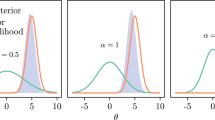Abstract
Some classical uncertainty quantification problems require the estimation of multiple expectations. Estimating all of them accurately is crucial and can have a major impact on the analysis to perform, and standard existing Monte Carlo methods can be costly to do so. We propose here a new procedure based on importance sampling and control variates for estimating more efficiently multiple expectations with the same sample. We first show that there exists a family of optimal estimators combining both importance sampling and control variates, which however cannot be used in practice because they require the knowledge of the values of the expectations to estimate. Motivated by the form of these optimal estimators and some interesting properties, we therefore propose an adaptive algorithm. The general idea is to adaptively update the parameters of the estimators for approaching the optimal ones. We suggest then a quantitative stopping criterion that exploits the trade-off between approaching these optimal parameters and having a sufficient budget left. This left budget is then used to draw a new independent sample from the final sampling distribution, allowing to get unbiased estimators of the expectations. We show how to apply our procedure to sensitivity analysis, by estimating Sobol’ indices and quantifying the impact of the input distributions. Finally, realistic test cases show the practical interest of the proposed algorithm, and its significant improvement over estimating the expectations separately.




Similar content being viewed by others
References
Broto, B., Bachoc, F., Depecker, M.: Variance reduction for estimation of Shapley effects and adaptation to unknown input distribution. SIAM/ASA J. Uncertain. Quantif. 8(2), 693–716 (2020)
Bucklew, J.: Introduction to Rare Event Simulation. Springer, Berlin (2004)
Chen, Y., Gupta, M.R., Chen, Y., et al.: EM demystified: an expectation-maximization tutorial. Electric. Eng. (2010)
Cornuet, J.M., Marin, J.M., Mira, A., et al.: Adaptive multiple importance sampling. Scand. J. Stat. 39(4), 798–812 (2012)
Davis, P.J., Rabinowitz, P.: Methods of numerical integration. Cour. Corp. (2007)
De Boer, P.T., Kroese, D.P., Mannor, S., et al.: A tutorial on the cross-entropy method. Ann. Oper. Res. 134(1), 19–67 (2005)
Demange-Chryst, J., Bachoc, F., Morio, J.: Shapley effect estimation in reliability-oriented sensitivity analysis with correlated inputs by importance sampling. Int. J. Uncertain. Quantif. 13(3) (2023)
Dempster, A.P., Laird, N.M., Rubin, D.B.: Maximum likelihood from incomplete data via the EM algorithm. J. Roy. Stat. Soc.: Ser. B (Methodol.) 39(1), 1–22 (1977)
Geyer, S., Papaioannou, I., Straub, D.: Cross entropy-based importance sampling using Gaussian densities revisited. Struct. Saf. 76, 15–27 (2019)
Glynn, P.W., Szechtman, R.: Some new perspectives on the method of control variates. In: Monte Carlo and Quasi-Monte Carlo Methods 2000. Springer, p 27–49 (2002)
Hansen, L.P.: Large sample properties of generalized method of moments estimators. Econom. J. Econom. Soc. pp. 1029–1054 (1982)
He, H.Y., Owen, A.B.: Optimal mixture weights in multiple importance sampling. arXiv preprint arXiv:1411.3954 (2014)
Helton, J.C., Davis, F.J.: Latin hypercube sampling and the propagation of uncertainty in analyses of complex systems. Reliab. Eng. Syst. Saf. 81(1), 23–69 (2003)
Homma, T., Saltelli, A.: Importance measures in global sensitivity analysis of nonlinear models. Reliab. Eng. Syst. Saf. 52(1), 1–17 (1996)
Jagannathan, R., Skoulakis, G., Wang, Z.: Generalized methods of moments: applications in finance. J. Bus. Econ. Stat. 20(4), 470–481 (2002)
Kahn, H., Harris, T.E.: Estimation of particle transmission by random sampling. Natl. Bureau Stand. Appl. Math. Ser. 12, 27–30 (1951)
Kraft, D.: A software package for sequential quadratic programming. Forschungsbericht- Deutsche Forschungs- und Versuchsanstalt fur Luft- und Raumfahrt (1988)
Kullback, S., Leibler, R.A.: On information and sufficiency. Ann. Math. Stat. 22(1), 79–86 (1951)
Kurtz, N., Song, J.: Cross-entropy-based adaptive importance sampling using Gaussian mixture. Struct. Saf. 42, 35–44 (2013)
Leluc, R., Portier, F., Segers, J.: Control variate selection for Monte Carlo integration. Stat. Comput. 31(4), 1–27 (2021)
Li, B., Zhang, L., Zhu, X., et al.: Reliability analysis based on a novel density estimation method for structures with correlations. Chin. J. Aeronaut. 30(3), 1021–1030 (2017)
Marin, J.M., Pudlo, P., Sedki, M.: Consistency of the adaptive multiple importance sampling. arXiv preprint arXiv:1211.2548 (2012)
Morio, J.: Influence of input PDF parameters of a model on a failure probability estimation. Simul. Model. Pract. Theory 19(10), 2244–2255 (2011)
Nelson, B.L.: On control variate estimators. Comput. Oper. Res. 14(3), 219–225 (1987)
Nelson, B.L.: Control variate remedies. Oper. Res. 38(6), 974–992 (1990)
Owen, A., Zhou, Y.: Safe and effective importance sampling. J. Am. Stat. Assoc. 95(449), 135–143 (2000)
Owen, A.B.: Monte Carlo theory, methods and examples (2013)
Owen, A.B.: Sobol’indices and Shapley value. SIAM/ASA J. Uncertain. Quantif. 2(1), 245–251 (2014)
Owen, A.B., Zhou, Y.: Adaptive importance sampling by mixtures of products of beta distributions. Citeseer (1999)
Rubinstein, R.Y., Kroese, D.P.: The Cross-entropy Method: A Unified Approach to Combinatorial Optimization. Monte-Carlo Simulation and Machine Learning, Springer, Berlin (2013)
Rubinstein, R.Y., Kroese, D.P.: Simulation and the Monte Carlo Method. Wiley, Hoboken (2016)
Saltelli, A., Tarantola, S., Campolongo, F., et al.: Sensitivity Analysis in Practice: A Guide to Assessing Scientific Models, vol. 1. Wiley Online Library, Hoboken (2004)
Sobol, I.M.: Sensitivity analysis for non-linear mathematical models. Math. Modell. Comput. Exp. 1, 407–414 (1993)
Zhang, P.: Nonparametric importance sampling. J. Am. Stat. Assoc. 91(435), 1245–1253 (1996)
Zhou, C., Lu, Z., Zhang, L., et al.: Moment independent sensitivity analysis with correlations. Appl. Math. Model. 38(19–20), 4885–4896 (2014)
Acknowledgements
The first author is enrolled in a Ph.D. program co-funded by ONERA-The French Aerospace Lab and Toulouse III - Paul Sabatier University. Their financial supports are gratefully acknowledged.
Author information
Authors and Affiliations
Contributions
Julien Demange-Chryst: conceptualization, methodology, formal analysis, investigation, software and numerical results, writing-original draft preparation, writing-review. François Bachoc: conceptualization, methodology, formal analysis, investigation, writing-review, supervision. Jérôme Morio: conceptualization, methodology, formal analysis, investigation, writing-review, supervision. All authors have read and agreed to the published version of the manuscript.
Corresponding author
Ethics declarations
Conflict of interest
The authors declare no competing interests.
Additional information
Publisher's Note
Springer Nature remains neutral with regard to jurisdictional claims in published maps and institutional affiliations.
Appendix A: Equivalence between both optimization problem
Appendix A: Equivalence between both optimization problem
Let us prove that the optimization problem in Eq. (18) is equivalent to the one in Eq. (21). Consider a sequence \(\varvec{\alpha }\in S_J\), a family of IS auxiliary distributions \(\left( g_{\varvec{\lambda }_j}\right) _{j\in [\![1,J]\!]}\), a family of control parameters \(\left( \beta _j\right) _{j\in [\![1,J]\!]}\in {\mathbb {R}}^J\) and a family of positive weights \(\left( w_j\right) _{j\in [\![1,J]\!]}\in {\mathbb {R}}_+^J\).
For any \(j\in [\![1,J]\!]\) and any IS auxiliary distribution h, we have:
Therefore, we have:
Since the term \(\sum _{j=1}^J w_jc_j\) does not depend on the sequence \(\varvec{\alpha }\), minimizing \(\sum _{j=1}^J w_j{\mathbb {V}}_{g_{\varvec{\alpha }}}\left( \dfrac{\phi _j\left( {\textbf{X}} \right) f_j\left( {\textbf{X}}\right) -\beta _j g_{\varvec{\lambda }_j}\left( {\textbf{X}}\right) }{g_{\varvec{\alpha }}\left( {\textbf{X}}\right) }\right) \) w.r.t. \(\varvec{\alpha }\) is then equivalent to minimize \({\mathbb {E}}_{h}\left[ \dfrac{\sum _{j=1}^Jw_j\left( \phi _j\left( {\textbf{X}} \right) f_j\left( {\textbf{X}}\right) -\beta _j g_{\varvec{\lambda }_j}\left( {\textbf{X}}\right) \right) ^2}{g_{\varvec{\alpha }} \left( {\textbf{X}}\right) h\left( {\textbf{X}}\right) }\right] \) w.r.t. \(\varvec{\alpha }\). As a conclusion, both optimization problems in Eqs. (18) and (21) are equivalent.
Rights and permissions
Springer Nature or its licensor (e.g. a society or other partner) holds exclusive rights to this article under a publishing agreement with the author(s) or other rightsholder(s); author self-archiving of the accepted manuscript version of this article is solely governed by the terms of such publishing agreement and applicable law.
About this article
Cite this article
Demange-Chryst, J., Bachoc, F. & Morio, J. Efficient estimation of multiple expectations with the same sample by adaptive importance sampling and control variates. Stat Comput 33, 103 (2023). https://doi.org/10.1007/s11222-023-10270-y
Received:
Accepted:
Published:
DOI: https://doi.org/10.1007/s11222-023-10270-y




